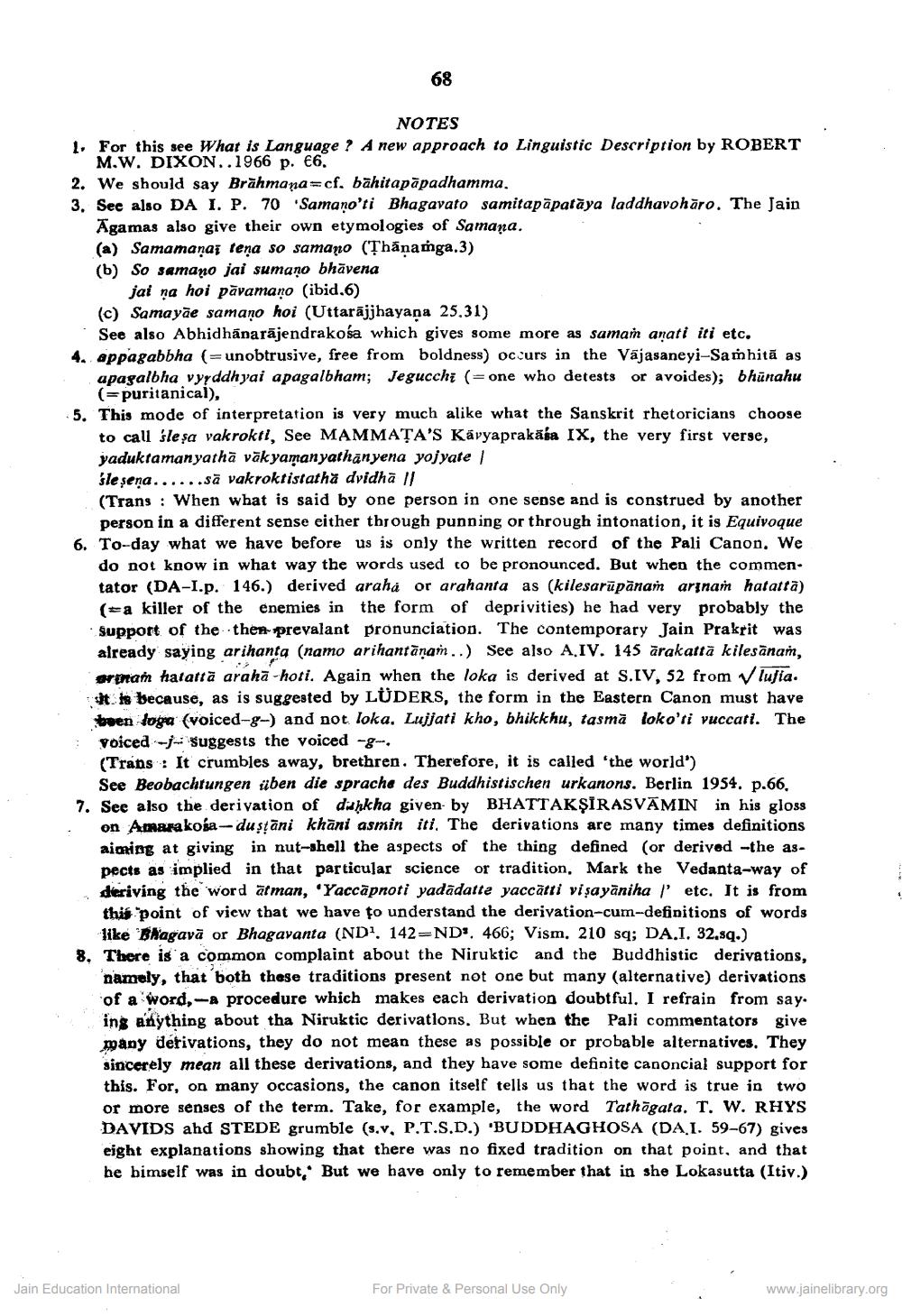________________
68
NOTES 1. For this see What is Language ? A new approach to Linguistic Description by ROBERT
M.W. DIXON..1966 p. €6. 2. We should say Brāhmana=cf. bahitapāpadhamma. 3. See also DA I. P. 70'Samano'ti Bhagavato samitapāpatāya laddhavohāro. The Jain
Agamas also give their own etymologies of Samana. (a) Samamaņai tena so samano (Thānanga.3) (b) So samano jai sumano bhāvena
jai na hoi pāvamano (ibid.6) (c) Samayāe samano hoi (Uttarājjhayana 25,31)
See also Abhidhānarājendrakośa which gives some more as sama anati iti etc. 4. appagabbha (=unobtrusive, free from boldness) occurs in the Vājasaneyi-Samhitā as : apagalbha vyrddhyai apagalbham; Jegucchi (=one who detests or avoides); bhūnahu
(=puritanical), 5. This mode of interpretation is very much alike what the Sanskrit rhetoricians choose
to call śleşa vakrokil, See MAMMAȚA'S Kávyaprakasa IX, the very first verse, yadukramanyathā vākyamanyathanyena yojyate śleşena......sā vakroktistatha dvidhä // (Trans : When what is said by one person in one sepse and is construed by another
person in a different sense either through punning or through intonation, it is Equivoque 6. To-day what we have before us is only the written record of the Pali Canon. We
do not know in what way the words used to be pronounced. But when the commen. tator (DA-I.p. 146.) derived araha or arahanta as (kilesarūpānam ar nam hatatra) (=a killer of the enemies in the form of deprivities) he had very probably the Support of the then prevalant pronunciation. The contemporary Jain Prakrit was already saying arihanta (namo arihantānam..) See also A.IV. 145 ārakatta kilesanan, armann hatattă araha -hoti. Again when the loka is derived at S.IV, 52 from lusia. et is because, as is suggested by LUDERS, the form in the Eastern Canon must have been loga (voiced-g-) and not loka, Lujjati kho, bhikkhu, tasmā loko'ri vuccati. The voiced-j- suggests the voiced -- (Trans : It crumbles away, brethren. Therefore, it is called 'the world')
See Beobachtungen üben die sprache des Buddhistischen urkanons. Berlin 1954. p.66. 7. See also the derivation of duḥkha given by BHATTAKSIRASVĀMIN in his gloss
on Amarakośa-duşțāni khāni asmin iti. The derivations are many times definitions aiming at giving in nut-shell the aspects of the thing defined (or derived the aspects as implied in that particular science or tradition, Mark the Vedanta-way of deriving the word alman, 'Yaccāpnoti yadadatte yaccătti vișayāniha / etc. It is from this point of view that we have to understand the derivation-cum-definitions of words
like Bhagavā or Bhagavanta (NDI. 142=ND, 466; Vism. 210 sq; DA.I. 32.sq.) 8. There is a common complaint about the Niruktic and the Buddhistic derivations,
namely, that both these traditions present not one but many (alternative) derivations of a word,-a procedure which makes each derivation doubtful. I refrain from say. ing anything about tha Niruktic derivations. But when the Pali commentators give many derivations, they do not mean these as possible or probable alternatives. They sincerely mean all these derivations, and they have some definite canoncial support for this. For, on many occasions, the canon itself tells us that the word is true in two or more senses of the term. Take, for example, the word Tathāgata. T. W. RHYS DAVIDS ahd STEDE grumble (s.v, P.T.S.D.) 'BUDDHAGHOSA (DAI. 59-67) gives eight explanations showing that there was no fixed tradition on that point, and that be bimself was in doubt. But we have only to remember that in she Lokasutta (Itiv.)
Jain Education International
For Private & Personal Use Only
www.jainelibrary.org




